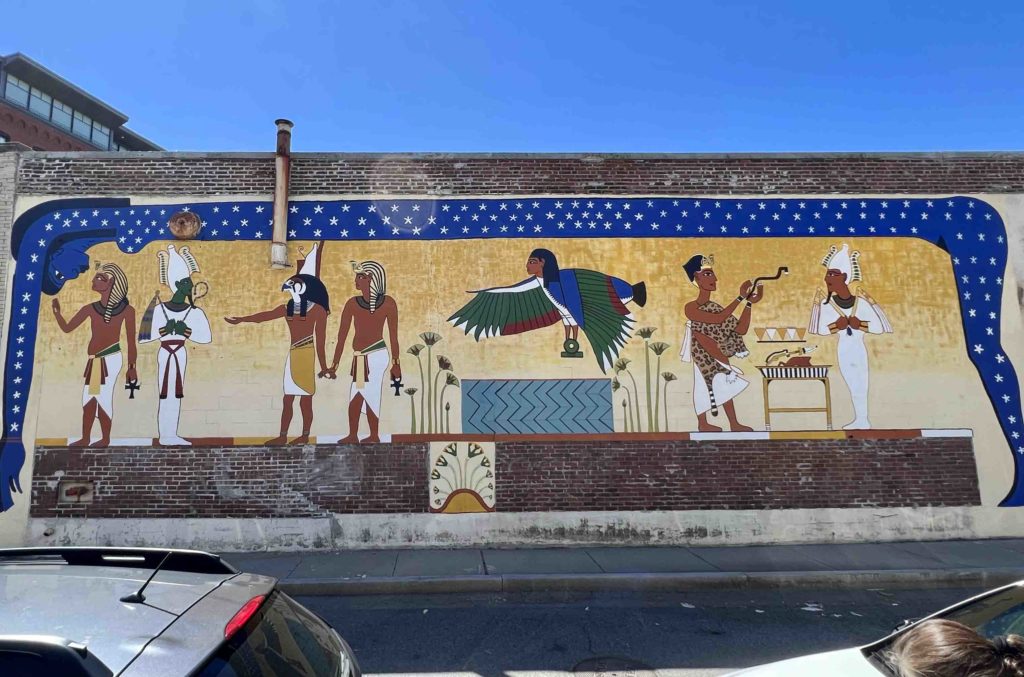Permanent Boston Mural Designed by Bobby Zabin (I)
For the past two summers, senior Bobby Zabin has worked as part of the Mayor’s Mural Crew—a City of Boston Parks and Recreation program, whose goal is to enhance the style and visual landscape of Boston neighborhoods. This summer, Bobby was commissioned by the program’s leadership to design and execute a large-scale, permanent mural—15 feet tall by 60 feet long—intended to promote National Geographic’s Beyond King Tut immersive exhibit, which is currently installed at the SoWa Power Station on Harrison Avenue. Bobby is the first high school student invited to design a mural for the program in the Crew’s recent history.
Bobby’s charge was to design—and then lead the execution of—a mural in the Ancient Egyptian style that would draw people’s eyes and interest in the adjacent King Tut exhibit. Drawing upon his love of art, his knowledge gained from Dr. Sue McCrory’s AP Art History class, and his experience with the Mural Crew, Bobby was up to the task.
“The first thing I did was look at the actual murals in King Tut’s tomb, which are more than 3,000 years old,” Bobby says. “Some of the research took me a while, because the material is not in English. Then I spent time looking at other funeral art from Ancient Egypt. Once I had an idea of what I wanted to create, and what story I wanted to depict, I used an app on my phone where I can just draw, and so I made my own.”
The crew working on Bobby’s mural included 15 high school students from schools throughout Boston, as well as three college-aged facilitators—all supported, ultimately, by Heidi Schork, the program’s long-time director. Together they worked over two and a half weeks, first erecting their scaffolding and then priming the wall with a neutral, cream-color acrylic paint. Once that priming layer was dry, the group began sketching out the figures and shapes—according to Bobby’s design—with a thin layer of orange paint.
“The story that the mural depicts is really similar to the one in King Tut’s actual tomb,” explains Bobby. “It’s essentially him being welcomed into the afterlife by various Ancient Egyptian gods. Once we sketched out the major figures, the majority of the work became filling in the lines. Because it’s designed in the Ancient Egyptian style, the art is pretty simple—it’s not very detailed or naturalistic. It’s basically colors and shapes.”
What Bobby learned in Dr. McCrory’s Art History class last year helped inform and prepare him for designing a mural of this style and scope.
“One of the units in that course was actually Ancient Egyptian art. In the AP Art History curriculum, on the test, there are 250 objects you have to know from across time and across history. One of those objects is a papyrus from Ancient Egypt about a man who’s being judged by the gods on his journey to the afterlife. Having researched that, I had a lot of material and a lot of prior knowledge that I could use to better research and design this new mural. That class prepared me to analyze and understand this type of art in a way I wouldn’t have otherwise. The Egyptian style is remarkable, because it basically didn’t change for all of that kingdom’s history. It’s one of the only really concrete art forms that persists, essentially unchanged, over thousands of years. Knowing and understanding it well, I was able to point out mistakes that my fellow crew mates were making, so that we could honor these Ancient Egyptian murals. For instance, in this style there is never an item depicted smaller in the background in order to create an illusion of depth or distance. Egyptian murals are considered to be rather ‘flat’ and lacking depth perspective. So, people would try to paint a small plant behind a figure, to make it look far away, and I was like, ‘You can’t do that. They didn’t do that.’”
The realities of painting outdoors all day, on scaffolding, in the hot, summer sun present logistical challenges, but Bobby claimed that the biggest challenge was being in charge.
“I wasn’t really expecting all these people to be asking me what to do—even though I designed the mural! Every minute I was painting, someone would inevitably come up and ask, ‘Bobby, is this the right color?’ or ‘Should this go there?’ or ‘Does this look right?’ I’d have to stop what I was doing to help or take a look, which could be frustrating. But, it also made me feel good, that they were looking to me for guidance, and that I had the answers.
“Stepping back and looking at the completed mural—with everyone looking at it, taking pictures, asking their parents and relatives to come look at it—made me feel really proud, of myself and of everyone who worked on it. It was such a hard thing to do, and we did it.”
For now, Bobby is working in his Studio Art class on his portfolio, which consists largely of watercolors—his favorite, small-format medium. His subject of choice these days is birds, and trying to connect them to Latin America—to his mom’s family’s history in Colombia.
Bobby’s King Tut mural, installed by the Mayors’ Mural Crew, lives at 471 Harrison Avenue in Boston. The mural project received press from all around the City, including by WCVB. The Mayor’s Mural Crew began in 1991 as a summer initiative to cover graffiti with murals painted and designed by high school students from the City of Boston. Over the course of the program, the Crew has engaged hundreds of young people. Its mission today is to create neighborhood landmarks within Boston’s parks and playgrounds. They offer creative job training opportunities beyond murals, with projects that include installations, public and green space design, temporary street art, pop-up exhibits and art, and community events.

